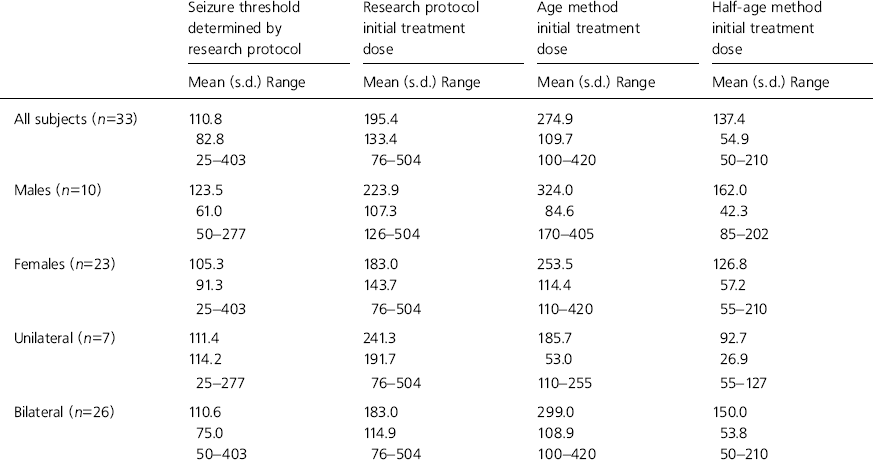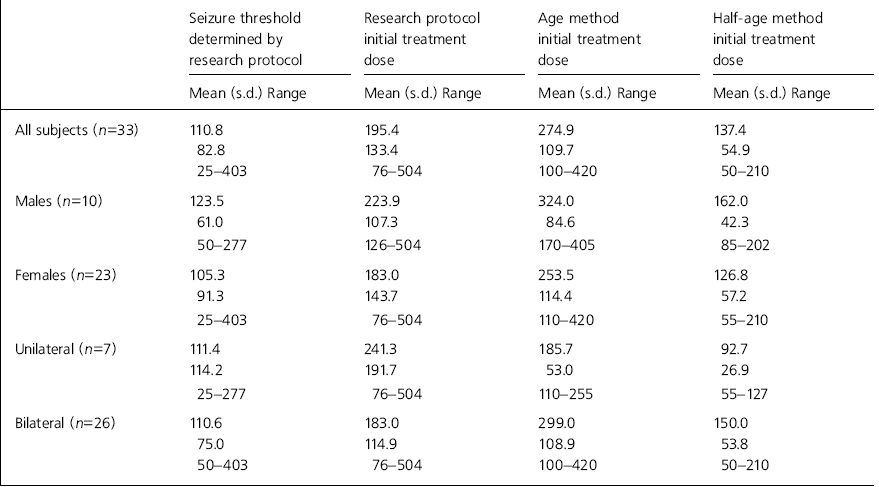The Royal College of Psychiatrists' guidelines advocate that the electrical dose given in electroconvulsive therapy (ECT) is adjusted for each patient to take into account variations in seizure threshold (Royal College of Psychiatrists, 1995). This technique is called stimulus dosing and two methods are used. Dose titration involves the application of increasing doses of electricity until the seizure threshold is determined. The alternative method of dose prediction involves giving a predetermined dose derived from an algorithm taking into account factors known to significantly influence seizure threshold. Pippard (Reference Pippard1992) found, however, British ECT clinics commonly use a standard ‘fixed dose’ to treat all patients.
Determining the stimulus dose may be important for several reasons. Sub-convulsive stimuli are clearly ineffective but marginally supra-threshold stimuli, despite producing seizures of apparently adequate length, are very poor at relieving depressive symptoms. The use of moderately supra-threshold stimuli significantly improves the efficacy of unilateral ECT and leads to a faster response to bilateral ECT. Increasing stimulus magnitude is also associated with a worsening of cognitive side-effects. Both efficacy and cognitive side-effects appear to be more closely related to the degree to which the stimulus exceeds the patient's seizure threshold rather than to the absolute magnitude of the electrical dose (Reference Sackeim, Prudic and DevanandSackeim et al, 1993). Utilising a MECTA SR1 machine, Enns & Karvelas (Reference Enns and Karvelas1995) found empirical titration to be a more consistent method of selecting an electrical dose than predictive methods. This study aimed to compare initial treatment dose determined by empirical dose titration with two simple dose prediction methods and a fixed-dose regimen utilising a Thymatron DGX constant-current machine.
The study
The study was conducted at the Queen Elizabeth Psychiatric Hospital, Birmingham. Subjects were recruited for a study investigating factors influencing the rate of onset of the antidepressant effect of ECT. Subjects were consecutive, voluntary, English-speaking patients, aged over 17 years, referred for ECT and giving informed consent for the main study. They all met DSM-IV criteria for major depressive episode (American Psychiatric Association, 1994) and had not had ECT within the previous three months. Puerperal depression was excluded.
No pre-medication was used and patients were anaesthetised with methohexitone (0.75 mg/kg) and paralysed with suxamethonium (0.5 mg/kg), the doses being adjusted according to clinical need. Atropine was not given routinely. Patients were hyperoxygenated prior to the initial stimulation. The research method for dose titration was a modification of that described by Lock in the ECT Handbook (Royal College of Psychiatrists, 1995). It was developed to accurately determine seizure threshold while keeping anaesthesia brief and maximising the chance of a patient having a therapeutic seizure during the first treatment session. Dose increments between different levels are initially small, increasing progressively in magnitude to cover the full range of the machine taking into account the proportionate relationship between stimulus dose and clinical outcome.
Starting levels for subjects (Table 1) were as follows: female unilateral (Level 1), male unilateral and female bilateral (Level 2), male bilateral (Level 3). Doses were increased by one level if patients were aged over 65 years or taking anticonvulsant medication. Seizure threshold was defined as the minimum electrical dose required to produce a generalised seizure lasting more than 25 seconds as measured by a single channel electroencephalogram recording via a left fronto-mastoid electrode placement. Following the first stimulation the electrical dose was increased by one level if there was no seizure (similarly for inadequate seizures). If there was no seizure on the second application the stimulus was increased by three levels for the final application. If the patient failed to have a seizure at the first treatment session, the titration process was continued at the next starting one level higher. If the patient previously had a seizure only on the third application, then the dose titration process was continued starting two levels lower. The dose titration process was similarly continued for a third ECT session if necessary. Subsequently initial treatment doses were set at seizure threshold plus one level for bilateral ECT and seizure threshold plus two levels for unilateral ECT.
Table 1. Stimulus levels for dose titration

| Level | Percentage energy | mC |
|---|---|---|
| 1 | 5 | 25 |
| 2 | 10 | 50 |
| 3 | 15 | 76 |
| 4 | 25 | 126 |
| 5 | 40 | 201 |
| 6 | 55 | 277 |
| 7 | 80 | 403 |
| 8 | 100 | 504 |
| 9 | 150 | 756 |
| 10 | 200 | 1008 |
Two dose prediction methods were compared with the research protocol. The age method described in the Thymatron manual (Reference Swartz and AbramsSwartz & Abrams, 1989) involves setting the stimulus control dial (percentage energy) to the patient's age. The second half-age method is similar but with the dose set to one half of the patient's age (Reference Petrides and FinkPetrides & Fink, 1996). In a previous audit (Reference Bentham, Callinan and Rodriguez-FererraBentham et al, 1998) 97% of stimuli were given with a dose of 275 mC (50% above mean seizure threshold), comparisons were also made with this fixed-dose regimen.
Findings
The study involved 10 males and 23 females with a mean age of 54.4 years (range 19-83 years). Seven subjects had unilateral and 26 bilateral treatment. Ten subjects required more than one stimulation during the determination of seizure threshold, although all subjects had their seizure threshold estimated by the end of the first ECT session. In other words, the research protocol initial stimulus dose under-estimated seizure threshold in just under one-third of subjects and overestimated or accurately predicted it in the remaining two-thirds. The research protocol led to a mean initial treatment dose of 195.4 mC (see Table 2). This was significantly lower than that derived by the age method (274.9 mC) (t=7.89, P <0.0001) and higher than that derived by the half-age method (137.4 mC) (t=1.75, P=0.09), as measured by a two-tailed paired t-test.
Table 2. Seizure threshold and initial treatment doses determined by three methods (values in mC)

| Seizure threshold determined by research protocol | Research protocol initial treatment dose | Age method initial treatment dose | Half-age method initial treatment dose | |
|---|---|---|---|---|
| Mean (s.d.) Range | Mean (s.d.) Range | Mean (s.d.) Range | Mean (s.d.) Range | |
| All subjects (n=33) | 110.8 | 195.4 | 274.9 | 137.4 |
| 82.8 | 133.4 | 109.7 | 54.9 | |
| 25-403 | 76-504 | 100-420 | 50-210 | |
| Males (n=10) | 123.5 | 223.9 | 324.0 | 162.0 |
| 61.0 | 107.3 | 84.6 | 42.3 | |
| 50-277 | 126-504 | 170-405 | 85-202 | |
| Females (n=23) | 105.3 | 183.0 | 253.5 | 126.8 |
| 91.3 | 143.7 | 114.4 | 57.2 | |
| 25-403 | 76-504 | 110-420 | 55-210 | |
| Unilateral (n=7) | 111.4 | 241.3 | 185.7 | 92.7 |
| 114.2 | 191.7 | 53.0 | 26.9 | |
| 25-277 | 76-504 | 110-255 | 55-127 | |
| Bilateral (n=26) | 110.6 | 183.0 | 299.0 | 150.0 |
| 75.0 | 114.9 | 108.9 | 53.8 | |
| 50-403 | 76-504 | 100-420 | 50-210 |
Discussion
Clinical opinion is currently divided on what is the most appropriate method of determining the stimulus dose for ECT. A survey of ECT practitioners in the USA reported that 12% used fixed-dose strategies, 39% dose titration and 49% formula-based methods (Reference Farah and McCallFarah & McCall, 1993). Empirical dose titration is currently the most accurate method for determining seizure threshold allowing the initial treatment stimulus to be set with similar accuracy within a ‘therapeutic window’ for both unilateral (2.25-4.5 times seizure threshold) and bilateral ECT (1.5-2.25 times seizure threshold). The ability of a dose prediction method to ensure an appropriately supra-threshold treatment stimulus is dependent entirely on its ability to accurately predict seizure threshold for an individual patient. In this study, the age method would have given an excessive dose in 20 subjects (60.6%) and resulted in a sub-threshold dose in up to two subjects (6.1%). In contrast, the half-age method would have led to an excessive dose in only four subjects (12.1%) and to a sub-threshold dose in up to eight subjects (24.2%). Only three subjects (9.0%) received 277 mC as an initial treatment dose and a fixed-dose regimen would have led to an inadequate dose in one subject (3.0%) and an excessive dose in 19 subjects (57.5%). It is probable that the experimental protocol over estimated the seizure threshold in some individuals because of its pragmatic design, however, the mean initial stimulus dose was fairly low and the range of seizure thresholds is consistent with other studies.
The accuracy of dose prediction methods in predicting initial seizure threshold on an individual patient basis is poor with only 30-50% of the variance being explained by multivariate models and much less with univariate paradigms (Reference WeinerWeiner, 1997). The clinical relevance of this inherent inaccuracy is dependent on the distribution of seizure thresholds in the treatment population and the mode of ECT administration. Forty-fold variations in seizure threshold have been reported in research populations, however, the range in clinical groups has been consistently reported as between six- and 12-fold (Reference WeinerWeiner, 1997). The range may be misleading as it is likely to reflect sample size and the standard deviation may be a more informative measure. If the spread of seizure thresholds is relatively narrow then dose titration may be unnecessary and a simple dose prediction method would be adequate for most patients. Dose titration could be reserved for situations where there is an increased likelihood of extreme variations in seizure threshold or where the initial response to a predicted dose is poor in terms of antidepressant effect or impaired cognition. Dose titration could be avoided in patients where there is increased anaesthetic risk, particularly if they were thought susceptible to bradyarrythmias.





eLetters
No eLetters have been published for this article.